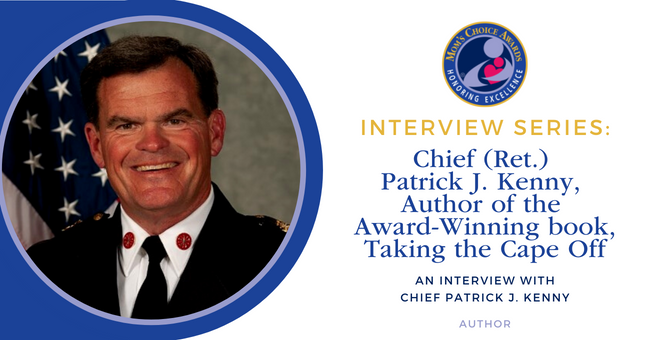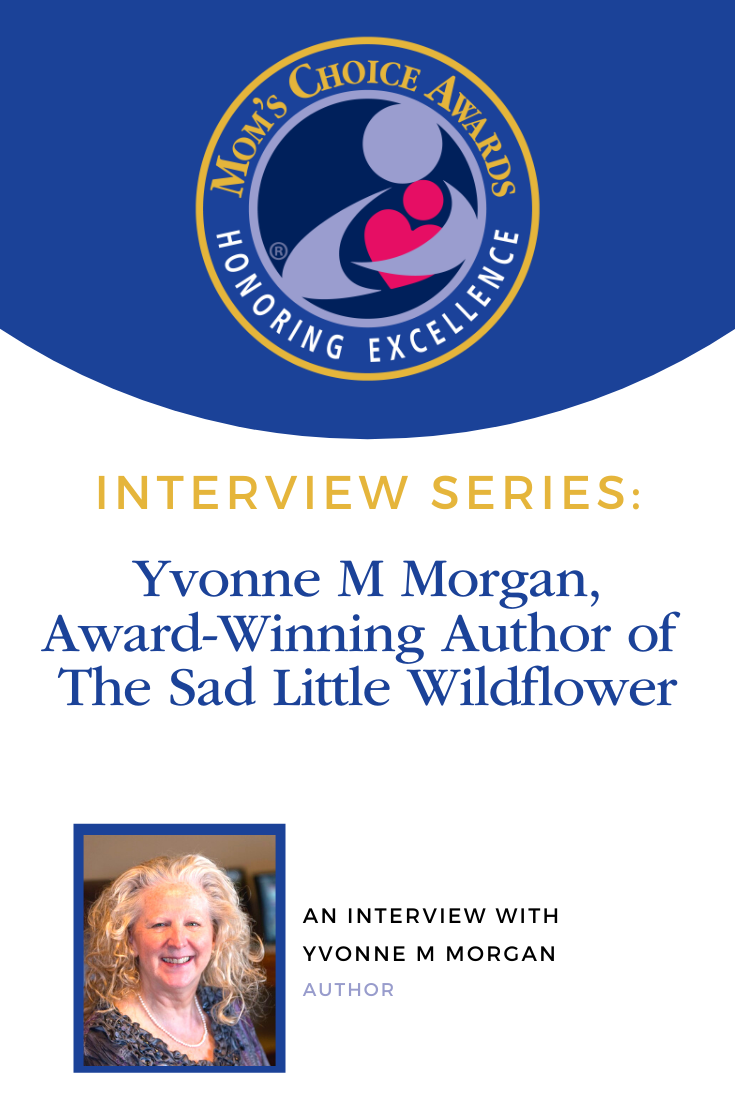Mom’s Choice Awards is excited to announce another post in our interview series where we chat with the inventors, designers, publishers, and others behind some of our favorite family-friendly products.
Hello, Mom’s Choice readers! We have a very special interview for you all today. MCA was extremely fortunate to be able to get the chance to speak with Chief Patrick J. Kenny (Retired) about his award-winning book, Taking The Cape Off: How to Lead through Mental Illness, Unimaginable Grief, and Loss. Taking the Cape Off shares Fire Chief Pat Kenny’s journey to overcome his perceived failure as a leader in his most cherished duty, that of being a protector. His “Cape” failed to protect his 20-year-old son Sean from dying by suicide after a lifelong battle with mental illness. His anguish was complicated by his role as the leader of a fire department. This comprehensive handbook is for leaders in any profession, for grief-stricken parents, and for anyone who struggles with the stigma of mental health.
Keep reading to find out more about Chief Patrick and his long and complicated journey that lead him to write his must-read, award-winning book, Taking The Cape Off.
MCA: Hello, Chief Patrick, thank you so much for allowing us to speak with you about Taking The Cape Off. This is truly an incredible book that gives anyone who reads it a completely new perspective and understanding of mental illness and how to deal with grief and anguish. Can I first start the interview by finding out a bit more about you?
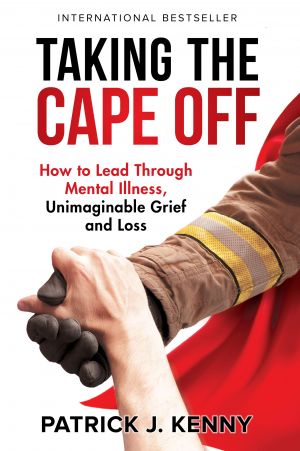
Chief Patrick J. Kenny’s MCA award-winning book, Taking The Cape Off!
Chief Patrick: I’ve been a member of the fire service for over 38 years, and before retiring in January 2021 served as the Fire Chief in Hinsdale and Western Springs, Illinois. I’ve been a Chief Officer for over 25 years and a speaker in multiple countries on Mayday for Mental Health® for more than a decade.
I’m very humbled to be an award-winning international best-selling author of Taking The Cape Off: How to Lead Through Mental Illness, Unimaginable Grief and Loss and have articles published in the areas of mental health, leadership, fire safety, and fire code challenges.
A few career award highlights include:
- Awarded the Fire Chief of the Year by the Illinois Fire Chiefs Association in 2004.
- Awarded Fire Chief Emeritus status by the Executive Board of the Illinois Fire Chiefs Association in 2021.
- Awarded the Fire Engineering/International Society of Fire Service Instructors (ISFSI) George D. Post Instructor of the Year Award for 2020-2021.
I was married thirty-five years to my wife Eileen before God took her to heaven in 2016 only eleven months after being diagnosed with glioblastoma, a terminal brain cancer. We were blessed with three wonderful sons, Brendan, Patrick, and Sean. Our youngest, Sean, was diagnosed with mental illness at the age of only five. He struggled most of his life with mental illness before he died by suicide in 2006.
To ensure his loss of life wasn’t in vain, I started speaking over a decade ago about mental illness within the firefighter profession which branched out to first responders and beyond. Before she passed, my wife Eileen encouraged me to keep spreading Sean’s message that mental illness is the same as any physical illness and to help remove the stigma.
MCA: There is no greater gift to give than to share one’s experience, especially one that has been as difficult as yours. I’m sure I can speak for many when I say thank you for that incredible gift. Can you tell us more about your journey of going from a Fire Chief to writing Taking The Cape Off?
Chief Patrick: As a Fire Chief, I never considered myself a writer or an author. Yes, I’ve written some articles over the years based on knowledge and experience, but I didn’t consider that the same kind of writing as a book. The truth of the matter is there would be no book at all if not for my wife, Eileen. She had been hounding me since our son Sean died by suicide after suffering most of his life with mental illness to write a book regarding his journey, and close behind her was my good friend Tim McElroy who also pushed.
The week Eileen died, she made me promise a handful of things, one of them was to write the book. I tried to weasel out of it by saying I would “try,” but after being with me for 35 years, she knew how to translate that into “nice try but promise you’ll write the book!” Really hard to turn down somebody who was already an angel on earth and is now on her way to being an official one. However, three years went by, and I had not even taken a shot at it even though Tim remained in my ear and occasionally, included a hint about you did make a promise!
A matter of what I call God’s intervention because I don’t believe in coincidences started in January 2019 in my Fire Chiefs role. I was in Ellen Baer, our Human Resource Director’s office, and we were discussing some subject I don’t even remember. Somehow, it got into a discussion about believing in signs, which led to me being introduced to her friend D.D. Marx, who had written several books based on her belief in signs and the great beyond. We met for dinner and exchanged those types of stories, and I asked her do you believe as an author, I have a story that anybody would be interested in? She gave me the answer I was not hoping for, and that was yes, you do! She then pointed me to her consultant who she had used Shannon O’Keeffe. I got the same answer from her, “we’re going to do this!” She then led me to a team of people, including Sarah Aschenbach, who edited the book, and Eric D. Groleau, who published the book. And the team also includes all the people who were kind enough to read the drafts of the book. A wonderful African proverb says it takes a village to raise a child. You could say, in my case, it took an army to inspire and produce a writer.
I began to write the book in earnest on April 17, 2019, and the reason I remember that date was my daughter-in-law Abbie was in labor with our first grandchild. The first few drafts I sent to Shannon, I’m sure she had second thoughts about whether this guy could pull it off. Six months into the attempt to write the book, COVID hit. So now, not only was I the Fire Chief sending firefighter/paramedic crews out into a situation where they had to worry about their safety as well as the possibility of bringing some disease home to their family, but I also was the emergency manager for our village. The first three months were pretty much 24/7 regarding availability, trying to craft standard operating procedures from something that didn’t exist, dealing with not only my personnel and Village employee’s anxiety but my own, and then trying to keep this book on the rails.
I look back now and wonder how it ever stayed on track, beyond knowing I had a couple of angels up there and a few down here encouraging me, but I think the thing that kept me going most was sometimes it was a relief. The book gave me structure in terms of following the writing schedules Shannon provided for me by placing topics in a box. In other words, my brain operates see this, do this. I needed that structure, and she gave that to me. It was the order I was missing with COVID.
I can tell you many days I wanted to quit. I was willing to go to heaven and look Eileen in the eyes and say, “honestly tried, but I just couldn’t do it,” and figured she might forgive me because of the pandemic. Some of the informational things were not hard to cover but reliving three significant losses, my father, my son Sean, and my Wife Eileen, brought back a lot of trauma I wasn’t ready for. Nightmares followed by feelings of depression and resurrecting that feeling of my Cape failing me would surface at times when it seemed almost impossible to climb over. It was during those times that those around me who love me encouraged me to keep going.
In June 2020, I had pretty much decided I was done writing. I was torn up between work and family and the book. The stresses drove me to a decision to take a break. I was going to call Shannon on a Tuesday and let her know. Unexpectedly she called me on that Monday and told me a story about a noise she had heard in her home when she was up in the middle of the night that scared her, and she couldn’t find the source. She said she heard a large “boom” and she jolted up in bed and her husband was still sleeping. She went down the hall and her teenage son’s bedroom door was closed and she thought she saw him standing outside of his room and when she turned on the lights no one was there and she checked on him and he was fast asleep. She said once she returned to bed and didn’t find anything, she heard a voice in her ear say, “you need to call him.” Now Shannon has many clients. I was not the only one, but she said, “I knew I was supposed to call you; why is that?” I then told her I was considering quitting. I just couldn’t do it anymore, but I realized that figure she saw down the hallway that she thought was her son was Sean. His nickname growing up was Boomer because we would just wait if we couldn’t find him and in the quiet suddenly you would hear a boom! When I imitated that noise for Shannon, she said, “Oh my goodness, that was the noise.” She then told me I had no choice; we were going to finish this thing! Sean knew she would believe enough to relay the story, and he also knew I needed that last kick in the butt to finish.
The goal became just to finish what I had started. I had no idea or inspiration to get an award for the book; I just wanted to keep my promise, and the response was amazing. So many people who never met Sean Kenny now know who he was; they are informed about the facts about mental illness and hopefully are provided hope through the stories of faith, signs, and resiliency. Eileen knew exactly what she was doing when she made me promise, and it certainly wasn’t because she picked the best writer. She just knew the one person who wouldn’t let her down.
MCA: That story gave me goosebumps and truly moved me to tears, thank you for sharing it, Chief Patrick! Divine intervention. I’m sorry to hear how painful this book was for you to write, but you came out on the other side and, based on the feedback from your readers, so many people are better off because of it! I know this may be difficult, but can you share with us your son’s journey through mental illness?
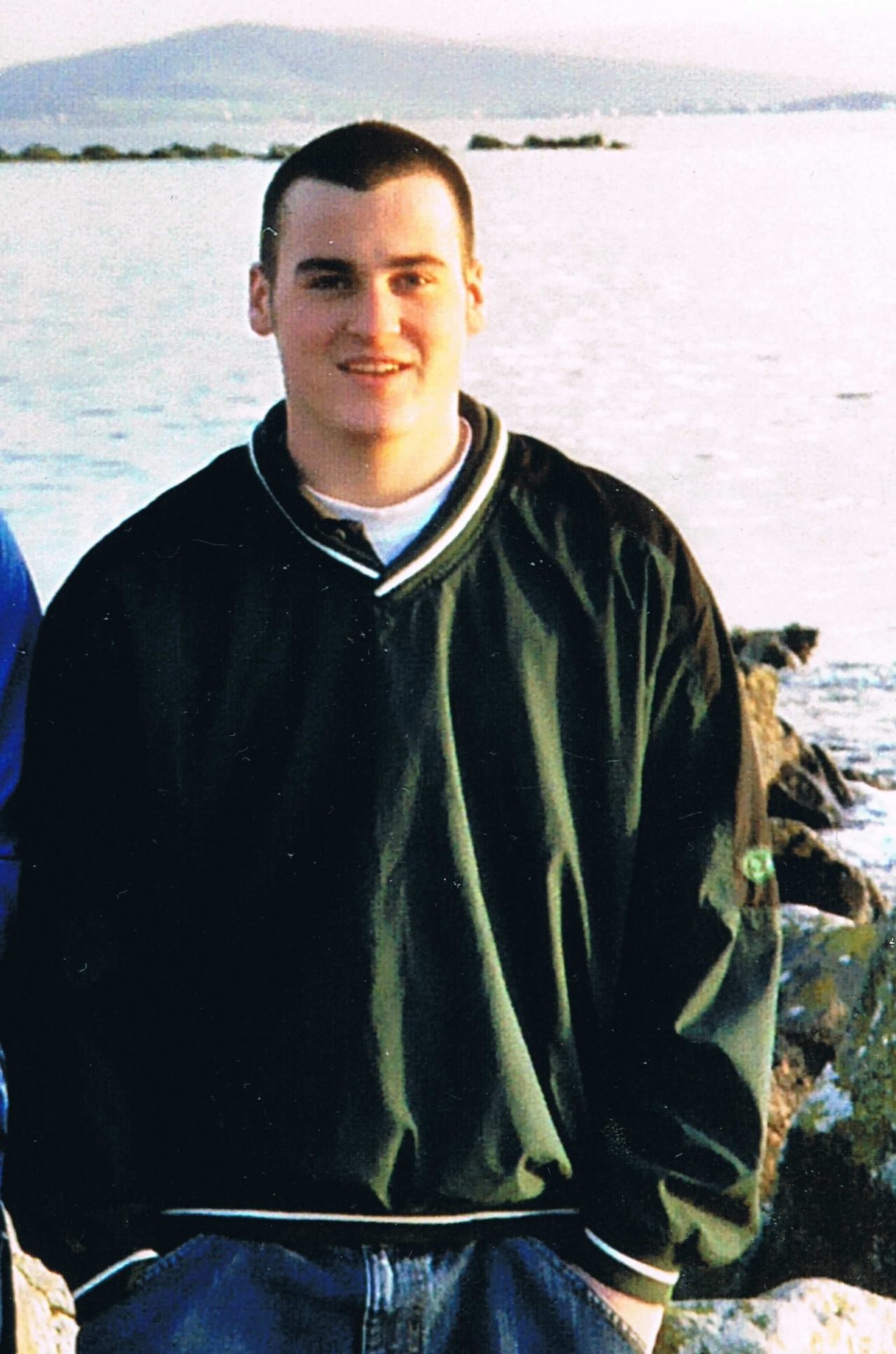
Chief Patrick J. Kenny’s son and inspiration behind “Sean’s Team,” Sean Kenny.
Chief Patrick: I smiled when I read this question because I thought that’s 300 pages of trying to explain a painful journey that there are parts I still don’t understand, so how do I make this brief? Sean was diagnosed with clinical depression at age five and fought like a warrior for 15 years before the disease became terminal, and he died by suicide. Throughout that journey, his true champion was his mom because I as his dad was too busy wearing the Cape to realize in the beginning that this was a physical disease, not a choice.
Sean was put on medication early and saw the counselor regularly, and until junior high, he did very well. He had a wonderful warm smile, a great sense of humor, and was a good athlete. People mistakenly believe those afflicted with mental illness are inferior. They are not inferior intelligence-wise or in any manner. Sean was a B+ student. However, when his hormones hit in junior high, it just took the disease to another level, where he was diagnosed with obsessive-compulsive disorder. Eileen and I agreed after he went to heaven that’s what really killed him. That disease took his life because he could not escape the intrusive thoughts that were so vile to him that he couldn’t take the pain anymore. There was no hope on the horizon, either medication or intervention, that was even touching his pain.
Sean was in and out of hospitals due to suicide attempts or journeys into facilities to try and see if a new medication or treatment would work. He would tirelessly search the Internet for the latest medications on the market to see if one of them might help his pain. He tried everything, including participating in a pilot program that put an implant in his chest. Unfortunately, they all failed.
For the first ten years or so, you could certainly still see that wonderful child inside that young man fighting for his life. The last five years were just attempting to survive. We took him to the Mayo Clinic to have a complete week of workup, and in the end, they said he was terminal. They compared it to 10 women with breast cancer. All were the same age, same stage diagnosis, and nine responded wonderfully to the treatment and recovered, and one died, and they don’t know why. They just knew the disease was too powerful. They told us that was Sean’s case, nothing was working, and every day, he decided not to take his life but to fight to stay one more day, and when that pain got too bad, he would leave.
Eileen once said after he passed that if love could’ve saved him, he certainly would still be here, and that’s so true. His mom was the love of his life, and he would do anything for her. He would not want her ever to be hurt. This disease was just stronger than love. I’m sure the journey was very lonely for him as he realized his buddies were not experiencing any of the pain he was going through and couldn’t understand what his journey was about. We tried our best, but it wasn’t good enough, and sometimes when I’m depressed and alone, I think, boy, this must just be a slight glimpse of what his life was like and how sad it would be if he died in vain without his life having meaning. That was Eileen’s vision to let people know who the real Sean Kenny was, and his life’s journey was about educating and providing hope, and his suffering was indeed not in vain.
MCA: Thank you for that brief glimpse into what Sean experienced during his 20 years of life. There is still so much we don’t know about mental illness, and that is why books like Taking The Cape Off are so incredibly important. Can you share with us some of the vital lessons that can be found in Taking The Cape Off?
Chief Patrick: There are many as the book has lessons learned after each chapter however, I will break it down into the following top three themes:
- MENTAL ILLNESS IS A PHYSICAL ILLNESS – First and foremost is that mental illness is a physical illness. It is not a character deficiency nor a weakness, and it is certainly not a choice any more than someone would choose to have brain cancer. Unfortunately, for a great part of the population, mental illness is not looked at in that way. It carries with it an unbelievable stigma that makes people feel like if they ask for help, they’re weak, makes them concerned about their jobs or ability to be promoted, as a leader makes you feel like you’re inept because if you can’t handle your life or those in your family or a coworker and then what kind of leader are you? Human beings are, by nature, caring beings, and then when mental illness comes into the picture, we are afraid to share that information with people who care about us. I was the number one offender of that by not telling family members or coworkers what Sean’s painful journey was like. I thought I was doing it to protect his reputation, and I believe that was part of the motive. Still, the other part was to protect my reputation because, as a leader, if I couldn’t protect my own son, how would I be able to protect the people in my department?
- NEVER LOSE HOPE – Another vital lesson is once you lose hope, you are on the path to possible self-destruction, to die by suicide. Hope can come in many different fashions, such as friends who know what you’re going through being able to just have a conversation with you, not fix what you’re going through but to let you know they’re there for you. I believe in a higher power, not a religion, but something out there bigger than me. Believing in something positive to hold on to is critical. I believe I’m probably not still standing on this earth if not for my faith. To go along with that is to believe in signs from that place, wherever it is that loved one sends you, to give you the hope that you’re not alone and the knowledge that someday when this earthly journey is done, there is indeed a reunion waiting for you so that loss of this earthly life does not become as totally devastating for those left behind.
- YOU ARE NOT PERFECT AND THAT’S OK – The other lesson is for leaders to realize that no one is perfect, we don’t know everything, and that striving for perfection can lead to a vicious cycle of depression that eventually will put that person in a position where they feel like they’re done being of any good to anybody. It’s in those moments that suicidal ideation creeps in, and if they make a plan, there’s a real good chance they’re going to act on it. The lesson for the leader is when they recognized a significant behavior change in a person, not to run in the other direction but to hit it head-on, and that is to ask the question as direct as it can be, “are you thinking of killing yourself?” The past false idea that if you talk about suicide to somebody, you’re encouraging them or suggesting it to them is inaccurate. But if you beat around the bush when you think they may be, it may allow them to skirt the issue. So hit it head-on and that same advice goes for you as the leader if you are experiencing similar feelings.
MCA: Those are all very powerful lessons and ones that do not come easily. What is the importance of having open lines of communication with someone who struggles with mental illness?
Chief Patrick: People who struggle with mental illness feel like they’re on an island. Some of that is the result of the stigma, and it’s an accurate portrayal as those around them don’t understand, and the person affected often doesn’t understand it either.
I truly believe the only way to keep somebody on this earth who’s suffering from a severe mental illness is for them to be able to talk. That doesn’t have to be to a psychologist; it could be to a coworker, friend, or family member, just someone to talk to! Studies on PTSD have shown that just talking about what you’re going through helps decrease the pain. It may not take it all the way, and in serious cases, you need professional help, but you can help minimize it just by having a conversation. That’s the reason that peer support is a vital component in helping people with their mental health regardless of their vocation in life. That’s not something just for first responders; that’s for everyone.
So, what steps do you take to begin the process with someone who may be suffering from mental illness?
- START THE CONVERSATION – The key is having the courage to open the conversation with them.
- MEET THEM WHERE THEY ARE – Be OK with the fact that they may not be ready to discuss the subject at that moment but by you having the courage to even address the fact that you’re concerned about them gives them permission in the future to reopen the discussion.
- DON’T TURN YOUR BACK BECAUSE YOU DON’T UNDERSTAND – When someone is struggling, don’t ignore them. People don’t look away because they don’t care, they ignore the topic because they don’t understand it. Unfortunately, that can look to the struggling person like they just don’t care. Don’t ever let anybody who’s struggling get that feeling because of your fear.
- ASK QUESTIONS – Instead, step into an arena that you think is going too far in asking questions rather than to not ask questions at all.
MCA: Tell us about the summaries listed at the end of each chapter and their significance!
Chief Patrick: In the book, you will find a page or two entitled “lessons learned” at the end of each chapter. That was something my consultant Shannon asked me to include in the book, and I fought tooth and nail against it! I didn’t want it to read like a textbook, and that’s what it reminded me of. However, she persuaded me that some people who read the book, may not be facing mental illness, loss of a child, loss of a spouse, or just that feeling of being totally inept in a leadership role, whether that be in your home or your business, but they may at a future time or know someone who is struggling. She said what you don’t want to have happen is the people read the book, have empathy for you, then put it on the shelf and never look at it again. If they’ve never been touched by any of those challenges, you want when, not if, they are struck by any of those human conditions, they won’t have time to read 300+ pages. What they can do is grab your book, open to the table of contents and look up the human condition they are facing; if they don’t have time to read the whole chapter, they can go to the last page and read the bullet points under lessons learned, and it may give them some peace in the immediacy of facing a difficult situation.
I have to eat humble pie as every time I do a book signing invariably, somebody will say to me their favorite part of the book is the lessons learned!!!
MCA: I have to agree with your consultant and fellow readers, those sections of the book make for incredible resources! I’ve read some of the reviews online for Taking The Cape Off and people have been blown away by it. It is clear that Sean’s message has had a huge impact on countless lives. Can you tell us what this response has been like for you?
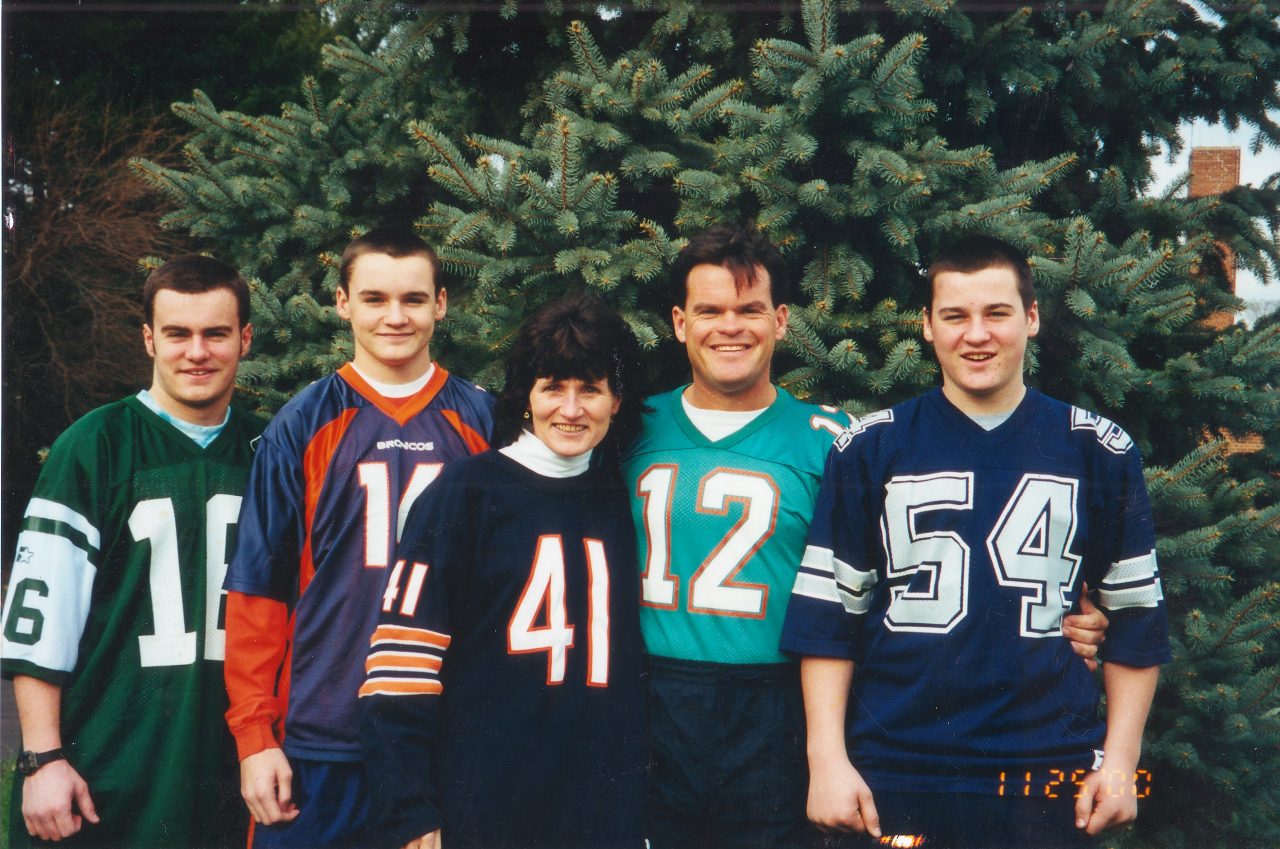
Chief Patrick J. Kenny’s family.
Chief Patrick: “Powerful” is the best description of the response that comes to mind. It is the word I use when trying to describe to family and friends the experiences I have had the honor to share when interacting with readers. Those can be either in person or via email, texts, phone calls, or various social media outlets. The stories of pain and loss suffered by so many people who were willing to be vulnerable to me, a stranger, by telling their stories reflect the fact that most of the human population experiences mental health challenges, either personally or with someone they care about or, in many cases, both.
This is not a physical illness that discriminates. It does not target the weak or first responders only. Indeed, the response confirms to me what I already had learned from Sean. This disease needs to see the light of day and be talked about openly so that those in need can not only seek help but feel empowered to do so void of negative consequences. We must take a proactive, not reactive, response to mental health education. The readers continuously encouraged me to “please keep doing what you’re doing; it is so needed!”
Sean’s suffering was not in vain. His impact from his heavenly spot is carried on now by the “Sean’s Team” members we have added, who promise me they will carry his message to others.
MCA: That is absolutely heartwarming. It is amazing that you have been able to create something so beautiful and meaningful out of such tragedy and loss. If you could ensure readers of your book walk away with one main lesson, what would it be?
Chief Patrick: Don’t judge what you don’t understand. Take the time to learn about mental illness. When you understand that it is indeed a physical illness and not a character deficiency, spread that word with conviction and courage. It is only in that way that the stigma attached to mental illness will be smashed.
MCA: The stigma associated with mental illness must end, and books such as Taking The Cape Off lead us closer to that goal every day. Thank you for writing such an impactful book as well as giving us even more insight with this interview. You are a real-life superhero!
You can learn more about chief Patrick J. Kenny and his award-winning book, Taking The Cape Off, by visiting his MCA Shop page.

